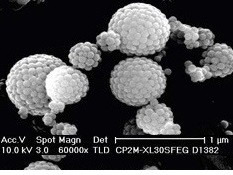|
|
|
Research
Interests
- Optical
characterization of nanoparticles and aggregs of nanoparticles
- Electromagnetic models
and light scattering techniques
- Complex particles
description and modeling
Projects
Recent publications
- J. Archer, M. Kolwas, G. Derkachov, M. Wo╝niak, D. Jakubczyk, K. Kolwas, Optical diagnostics of surfaces of single evaporating liquid microdroplet of solutions and suspensions, Proc. SPIE 9884, Nanophotonics VI, 988427 (April 19, 2016); DOI:10.1117/12.2225786
- M. Wo╝niak, G. Derkachov, K. Kolwas, J. Archer, T. T. Wojciechowski, D. Jakubczyk and M. Kolwas, Formation of Highly Ordered Spherical Aggregates from Drying Microdroplets of Colloidal Suspension, Langmuir, (2015), DOI: 10.1021/acs.langmuir.5b01621,
- G. Derkachov, D. Jakubczyk, M. Wo╝niak, J. Archer, M.
Kolwas, High-Precision Temperature Determination of
Evaporating Light-Absorbing and Non-Light-Absorbing Droplets,
J. Chem. Chem. B, 118, 12566−12574, (2014).
- R. Ho│yst, M. Litniewski, D. Jakubczyk, M. Zientara,
M. Wo╝niak, Nanoscale transport of energy and mass flux
during evaporation of liquid droplets into inert gas: computer
simulations and experiments, Soft Matter, 9, 7766 (2013).
Ph.D. Thesis
Wozniak M., Characterization
of nanoparticle aggregates with light scattering techniques, Ph.D.
thesis (in English); Marseille (France): Aix-Marseille University,
2012, WozniakM_PhD_2012.pdf.
This
Ph.D. work provides and evaluates various solutions to characterize,
with electromagnetic (optical) methods nanoparticles and aggregates of
nanoparticles found in suspensions, aerosols and dusty plasmas...
Particles
modelling
- DLA/DLCA
fractal-like aggregates
The
fully adjustable (tunable) DLA-type code was developed. It allows to
generate aggregates with
precisely defined morphological parameters, strict self-similarity and
scale-invariant properties [1].
DLCA code is under construction...
- Buckyball-like
aggregates
To
model very dense and highly opaque aggregates observed in aerosols we
developed a "Buckyball-like" model [2].
|

Numerically
generated fractal-like
aggregate
|
- Wo╝niak
M., Onofri F., Barbosa S., Yon J., Mroczka J., Comparison of methods to derive morphological parameters of
multi-fractal samples of particle aggregates from TEM images,
Journal of Aerosol Science, vol. 47, pp. 12-26, 2012.
- Onofri
F. R.A., Barbosa S., Toure O., Wo╝niak
M., Grisolia C., Sizing
buckyballs-like aggregates of
colloidal nanoparticles by light extinction spectroscopy,
Journal of Quantitative Spectroscopy and Radiative
Transfer, 2012, DOI 10.1016/j.jqsrt.2012.08.018
|
Light
Extinction Spectroscopy (LES)
LES
technique measures beam
transmission
of particles
illuminated by a polychromatic beam [1]. The beam
transmission depends on particles size distribution, concentration
and intrinsic properties.
This
leads to an ill-posed problem which
requires to inverse a Fredholm integral equation of the first kind. It
was solved with the least-square algorithm with a non-negative
constraint.
The experimental validation for nano silica beads, tungsten
aggregates [2] and
dusty plasma [1,3] proves potential of the LES technique.
|

SEM
image
of buckyball-like aggregates of nano silica beads
|
- Onofri
F., Wo╝niak
M., Barbosa S., On the optical characterization of
nanoparticle and their aggregates in plasma systems,
Contributions to Plasma Physics, vol. 51, pp. 1-9, 2011.
- Onofri F. R.A.,
Barbosa S., Toure O., Wo╝niak M., Grisolia C., Sizing buckyballs-like aggregates of
colloidal nanoparticles by light extinction spectroscopy,
Journal of Quantitative Spectroscopy and Radiative Transfer, 2012, DOI
10.1016/j.jqsrt.2012.08.018.
- Onofri
F., Barbosa S., Wo╝niak
M., Mroczka J., Vrel D., Grisolia C., In-situ
characterization of dust
mobilized by laser cleaning methods and loss of vacuum accident,
Fusion Science and Technology, vol. 61 (1), pp. 39-45, 2012.
|
TEM
analysis of fractal-like aggregates
As
a reference for scattering techniques [1] methods for the TEM-based
analyses were developed [2].
A
newly developed Modified Box-Counting Method (MBC) was found
to
provide less noisy estimation for the evolution of the fractal
dimension with the size of aggregates than widely
used multi-scale
analysis. With the MBC
method the mean fractal dimension of the experimental soot sample is
lower (1.66±0.02)
than the one derived with the
classical multi-scale analysis (1.88±0.02).
|
TEM
images of soot (left) and dusty
plasma (right) aggregates
|
- Mroczka
J., Wo╝niak
M., Onofri F.R.A., Algorithms and methods for the
analysis of the optical structure factor of fractal aggregates,
Metrology and Measurement Systems, vol. 19 (3), pp. 459-470, 2012.
- Wo╝niak
M., Onofri F., Barbosa S., Yon J., Mroczka J., Comparison of methods to derive morphological parameters of
multi-fractal samples of particle aggregates from TEM images,
Journal of Aerosol Science, vol. 47, pp. 12-26, 2012.
International
cooperation
IUSTI UMR CNRS
n░7343, Aix-Marseille University, Marseille,
France,
Fabrice Onofri, Ph.D. D.Sc, Director of Research at CNRS, personal website.
|
|

